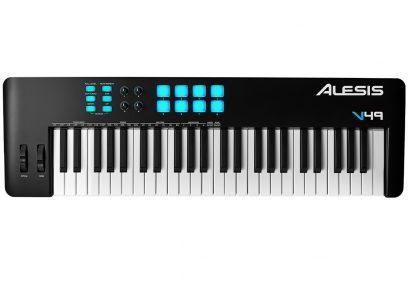Most of these differences are environmental and educational. For example, a composer can easily do their thing on the fly with a little 25 key MIDI keyboard, but for the most part often such gear is completely alien to them. This brings to mind hypothetical scenario of a concert violinist stuck in a room full of modular synth racks without a clue where to begin is funny, the inverse situation of a techno producer thrust into a soundproof room full of string instruments feeling like they’re musically incompetent is more disheartening.
Luckily this artistic divide is lessening, and a perfect example of this is the Virtual Piano Controller (VPC) by Kawai. Coming in with 88 wooden keys with physical hammers that faithfully replicate the crisp action of a Kawai grand, a sleek exterior with curves like a Maybach and a triple pedal with spring like the real thing, the VPC aims to set a new benchmark for MIDI keyboards. Even calling it a keyboard makes me feel like I’ve disrespected it deeply; it really is a fully fledged piano that just happens to produce MIDI data instead of soundwaves.
As a company that have been making pianos for close to 100 years, it is easy to understand Kawai’s design ethos, and it is this dedication to craftsmanship which delivers the most important part of this MIDI piano. The control of dynamics is unlike anything else, and something that classically trained musicians will find most satisfying. The feeling of playing music on a keyboard without dynamic control is akin to trying to express yourself in a language you don’t speak fluently. The touch of the VPC after using a standard MIDI controller is like taking off a heavy backpack after a day of walking, enough to make you think you’re playing like Glenn Gould for a hot minute. The ability to customise the touch response curves via Kawai’s VPC editor application (compatible with Mac or PC) gives you even more control over your desired expression.
With the emphasis on piano feel, the VPC keeps it simple with MIDI in and out ports, a USB B port which can power the entire unit, and a 12V AC port if needed. The VPC doesn’t feature any pitch bend abilities, which some may dislike. The ability to run this level of control and finesse into whatever synthesiser you desire is seriously mouthwatering.
The casing is incredibly sturdy and Kawai’s ability to balance luxury with restraint shines through with this model. The unit weighs in at a whopping 29.5 kg, so don’t expect to be able to lug this along to your next gig, this is a statement piece for your studio.
To me, the VPC feels like a coalescence of electronic and classical schools of thought. Whether you are looking for a full size keyboard that actually feels like a piano for your foray into the digital songwriting realm, or an electronic musician looking to explore the recondite art of dynamic control, or anywhere in between, the VPC is the gold standard of MIDI pianos. You don’t need to agree with my clumsy dichotomy between classical and electronic musicians to appreciate the Kawai’s approach to the MIDI piano. Some musicians have bridged the gap between the two disciplines of electronic music and classical music to achieve great artistic and commercial success. Kawai’s artisan angle has spawned the MIDI piano equivalent of this bridging, and I’m sure it will open up doors of creativity for many, regardless of whether their path mimics Kate Miller-Heidke’s classical-to-pop or James Blake’s dubstep-to-singer-songwriter route.

